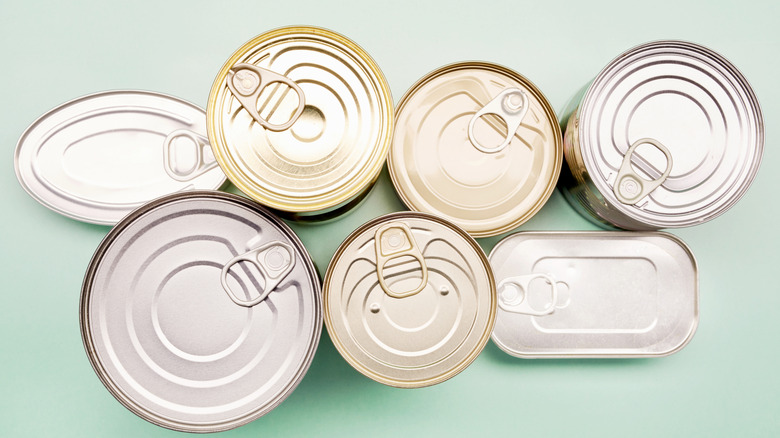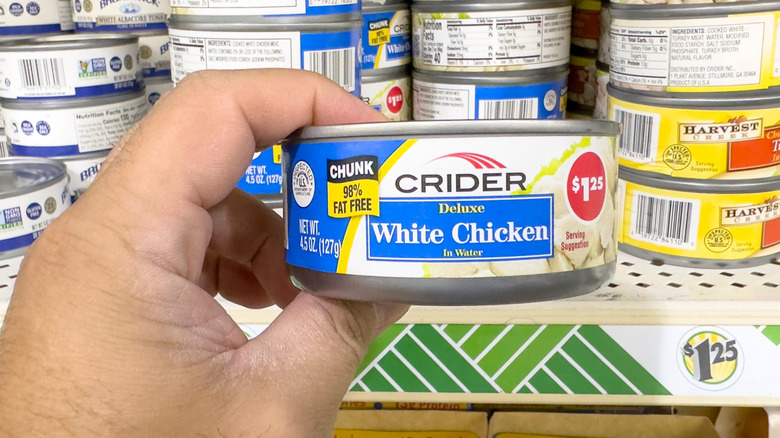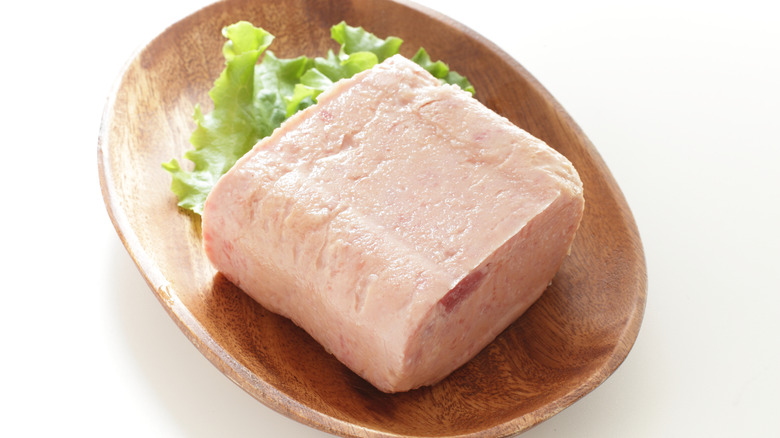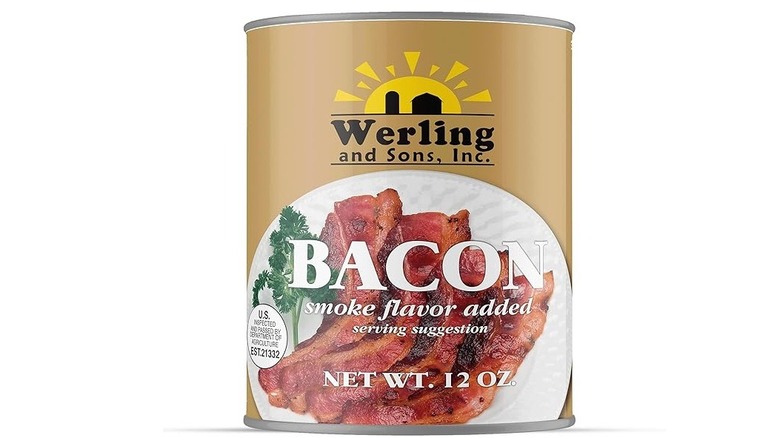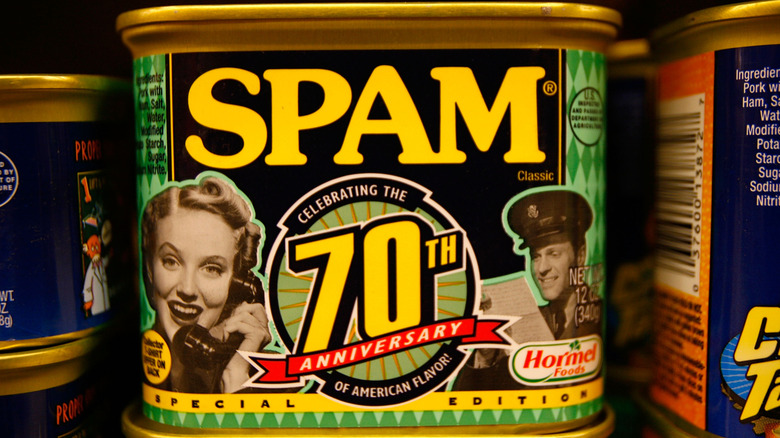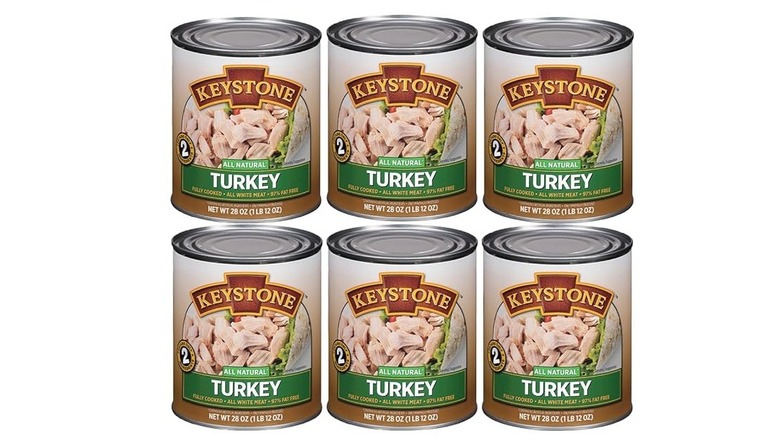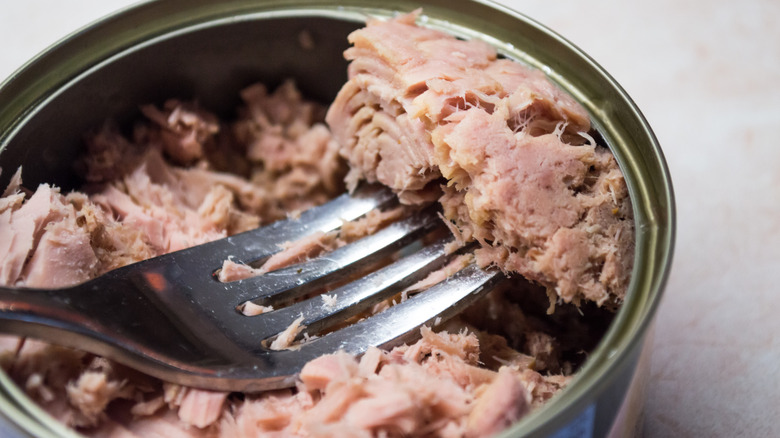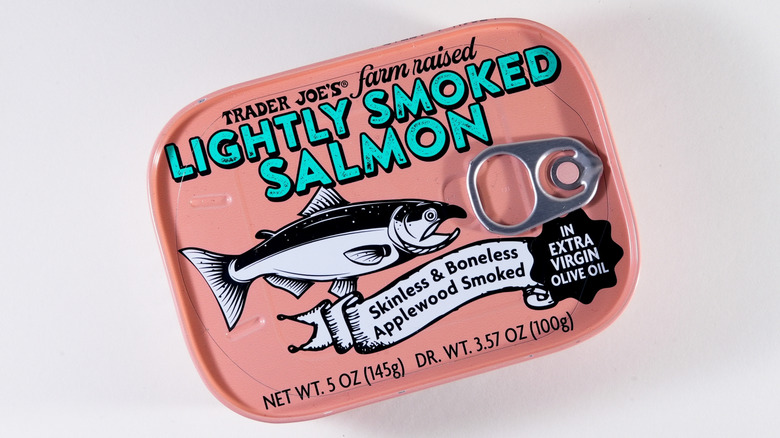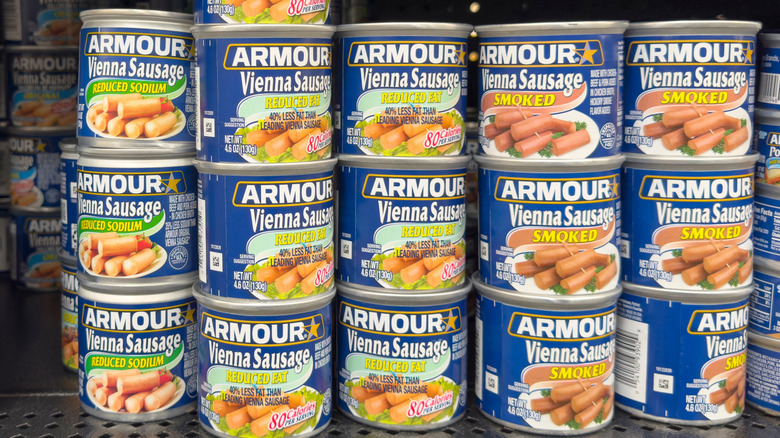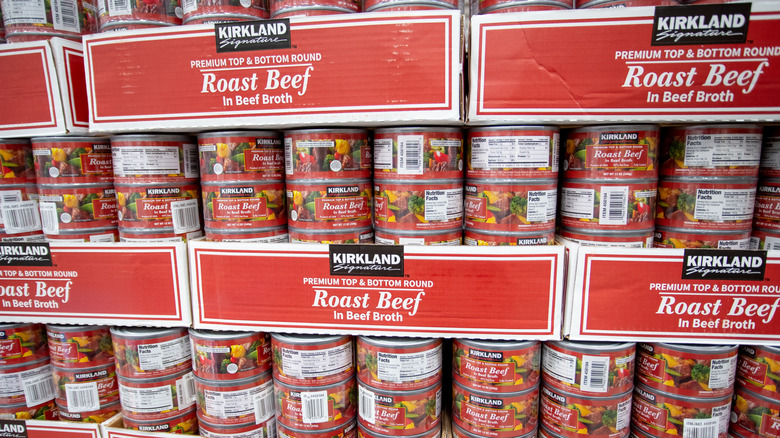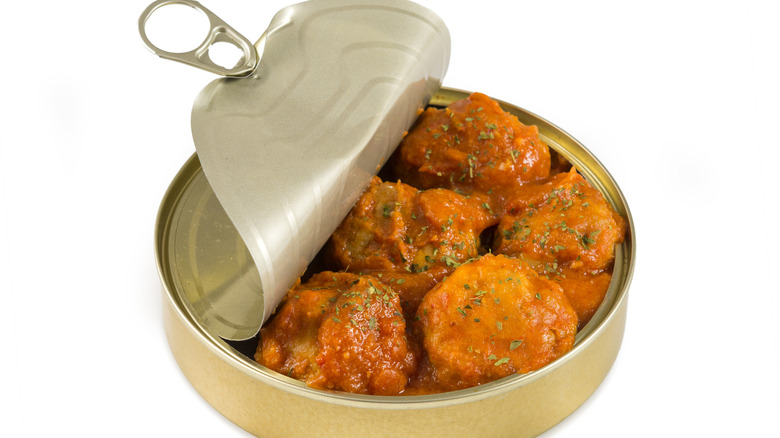Think Twice Before Buying These Canned Meats (And What To Buy Instead)
We may receive a commission on purchases made from links.
It's hard to believe now, but canned food was a revolution in its day. Invented in 1810 by Englishman Peter Durand, by 1870 tin cans were being manufactured in the United States, where Ezra Warner made everyone's life even easier by inventing the can opener. Since then, tins have been filled with almost every edible item possible, from juicy canned fruit and vegetables to milk and even bread. But one food in particular has been a resounding success: canned meat.
Most types of canned meat combine reasonably low-cost nutrition with ease of use. Who doesn't have an emergency can of chili, corned beef, or Spam in the pantry, ready to turn into a sandwich or throw into a pan at a moment's notice? Sadly, just as all that glitters isn't gold, not every meat in a can is good for you: Many include too much salt, artificial flavorings, and colorants. Canned meats, despite their convenience, can be a minefield.
So, which ones should you be aware of? Courtney Pelitera, registered dietitian nutritionist at Top Nutrition Coaching, and Sandra Zhang, RDN, pediatric dietitian at Tufts Medical Center, give their expert advice on a range of canned meats, and take a look at healthier alternatives.
Canned chicken
Consumers in the United States love to eat chicken above any other meat. While it's delicious cooked in a variety of ways, it can take time that many people simply don't have. No wonder there are so many chicken brands in stores, and in one way at least, it's good for us. "Canned chicken does not meet criteria for processed meats which increase cancer risk," said Courtney Pelitera, registered dietitian nutritionist.
While there isn't much difference between chicken breast from a can and the fresh kind when it comes to flavor, texture, and versatility, there is an issue: salt. Many brands add a broth or solution to the chicken so it stays moist but this can add between 80 and 200 milligrams of sodium per serving, according to Pelitera.
There are a couple of ways to avoid this. The first is to buy fresh chicken, but if you can't do that, check the labels – which may be listed as salt, sodium, or soda. Health agencies recommend a maximum of 2,300 milligrams per day for most adults. If you don't want to switch from a favorite brand but are concerned about salt levels, make sure to rinse the chicken after draining the can.
Canned ham
Millions of households have a can or two of ham in their cupboards, and it's easy to see why. Canned ham is a tasty source of protein that will keep for months or even years if unopened, is ready to eat in seconds, and can be used for more than just sandwiches. As with lots of canned goods, the range available caters to all budgets, and while some contain good quality meat, there are still a few fundamental issues.
Canned ham is processed and eating too much can increase the risk of heart disease and cancer. Processed meats, like canned ham, can also contain sugar, as well as nitrites, which enhance flavor or preserve the meat's pink color. Then there's salt. Canned ham can have between 600 to 800 milligrams of sodium per serving, according to Top Nutrition Coaching's Courtney Pelitera — and Sandra Zhang, pediatric dietitian at Tufts Medical Center, warned it is also high in fat.
One alternative is to buy fresh, uncured ham by the slice from the deli or supermarket, avoiding those covered in a glaze, as they contain more salt and sugar. If your budget doesn't stretch that far, Pelitera suggests baking a pork tenderloin or pork chop and slicing it thin to simulate the ham texture, reducing your fat and salt intake, while having a convenient source of meat protein on standby.
Canned bacon
This staple of survivalists and campsites – which has seen its fair share of wartime action and space adventures –may be thinner on the ground these days but brands like Werling and Sons are helping fans stock up on canned bacon. With a decade-long shelf life,it combines convenience with flavor but it's not the healthiest type of meat protein on the block.
The Werling and Sons brand contains 5 grams of both fat and protein per serving, putting it firmly in the high fat category for our experts. According to the label, its canned bacon also contains 190 milligrams of salt — 8% of an adult's daily intake — while providing just 5 grams of protein, a nutrient profile that's similar to fresh bacon, according to pediatric dietitian Sandra Zhang.
Although gluten free, Werling and Sons canned bacon also includes the preservatives sodium erythorbate and sodium nitrate, and the additive sodium phosphates. Anyone who does have some canned bacon in their cupboard is better off eating a small amount — and a healthier alternative is turkey bacon. Cook and freeze it for a tasty, convenient meat protein substitute.
Spam
The Monty Python comedians sang the praises of this canned meat that has been a kitchen staple in the United States and globally since its launch in 1937. It really took off during World War II, when more than 100 million pounds of it was sent to overseas soldiers. Since then, billions of people have cracked open a can of Spam, from the classic pork to today's wide range of flavors.
Despite Spam's popularity, Sandra Zhang, RDN, pediatric dietitian at Tufts Medical Center, is not its biggest fan, saying: "One can of regular Spam has 1,080 kilocalories, 96 grams fat, 4,620 milligrams sodium ([the] daily recommended limit is 2,300 milligrams), and only 49 grams protein." She noted the lite versions weren't much better, containing less fat but with a hefty 3,420 milligrams of salt.
As if the sodium content isn't enough to have our experts waving red flags, Spam also contains added sweeteners, thickeners and preservatives. Courtney Pelitera, registered dietitian nutritionist at Top Nutrition Coaching, said: "I would not recommend Spam for regular consumption." If you want all the convenience of a can of Spam without the salt or added ingredients, she recommended slicing up some regular cooked ham.
Canned turkey
Turkey is not just for Thanksgiving: The canned version is also a great cupboard standby, perfect for throwing into a lunchtime salad bowl or adding to pie filling. While some brands offer both dark and light turkey meat in a can, if you prefer breast only, Keystone and Lehman's have got you covered.
Canned turkey also has much less salt compared to other canned meats, with some products as low as 115 milligrams. Many brands use unprocessed meat with few extra ingredients, and Courtney Pelitera of Top Nutrition Coaching highlighted the fact canned turkey was not a "smoked or processed meat and did not contain carcinogens." That said, it can still have harmful nitrates in preservatives which sound natural, such as celery powder, juice, or salt.
Reading labels carefully can help you find a brand of canned turkey that is low in sodium and nitrates, but a healthier option is to freeze leftover turkey breast that has been cooked within the last three days. Pop it in the freezer for an hour on a sheet pan before cutting or cubing it to stop it from sticking together. Place it in a freezer-proof bag, clearly label it with the date, and it should keep for three to six months.
Canned tuna
According to the National Fisheries Institute, in 2022 canned tuna was the third most popular type of fish in the United States, with each person eating 2.2 pounds. While that's a healthy boost of omega 3 and 6 fatty acids for your body, canned tuna is also a convenient and low-cost source of protein. Mix it with mayonnaise and you have a classic sandwich, or throw it in with some tomato sauce for a hearty pasta bake.
While canned tuna has plenty of benefits, it's also worth paying attention to the labels when shopping. "Canned tuna can vary greatly in nutrition and packaging," warned registered dietitian nutritionist Courtney Pelitera, adding: "The ingredients should really just be tuna, salt, and water." While many consumers know that canned tuna contains mercury, they may not know about other additions.
Soy can be used to make the vegetable broth some tuna is canned in. For people with allergies or intolerances, this presents a problem. Some brands also add pyrophosphate, which reduces the formation of crystals on the fish when they are canned. According to the FDA, canned light Skipjack tuna, albacore, and yellowfin tuna are the best options. Try to buy tuna in water or olive oil, and always drain off the liquid.
Canned salmon
On the face of it, canned salmon can be a great way to enjoy protein without blowing the household budget, when compared to frozen or fresh varieties. It's flexible too: Rip open a can and add it to a warming chowder, make into burgers, or toss chunks into a crisp salad. Courtney Pelitera of Top Nutrition Coaching warned shoppers paying attention to their labels not to be put off by the high fat levels in canned salmon. "This is because salmon naturally has higher fat content with healthy omega 3 fatty acids in the natural oils," she said. As well as being essential for your eyes and brain, omega 3 fatty acids can also help prevent heart disease and strokes.
Despite all those advantages, canned salmon is not immune from the risk posed by additional salt. According to Nutrition Value, a 150-gram portion of canned salmon can contain 605 milligrams of salt, more than a quarter the daily recommended intake. While sodium levels are not as high as some canned meats, it's worth opting for brands with low or zero salt.
Canned Vienna sausages
An invention from the United States, millions of people loved Vienna sausage as kids, with their strange texture and almost indescribable flavor. Today, however, consumers know more about them, and a lot of the information about Vienna sausages isn't good.
Vienna sausage is often made with a mix of chicken, beef, and pork — but you can also find varieties with just chicken, like these from Grace. That might not sound too bad, but Vienna sausages can contain around 17 grams of fat per serving, and salt is a problem too: Amounts vary from 530 milligrams to 820 milligramsper serving. The list of ingredients can also include corn syrup, and the additive sodium erythorbate.
If you want a similar, meaty product without all those added extras, Courtney Pelitera, registered dietitian nutritionist, recommends investing in a turkey kielbasa sausage, which contains more protein and has a lower fat content. If you absolutely have to have a Vienna sausage, Armour Star's range includes a variety with 40% less fat.
Canned corned beef
Not many canned foods could claim to have fed both the British royal family and the country's soldiers during the World War I and II, but corned beef ticks both boxes. Instantly recognizable thanks to the trapezoidal tin and the little key that (sometimes) opens it: Canned corned beef has been a staple in the United States and worldwide for decades. Sandra Zhang, RDN, pediatric dietitian at Tufts Medical Center, gives it a thumbs up for the high levels of protein, a good source of iron, and its ability to add flavor to a dish.
However, there's no escaping the elephant in the room: Canned corned beef is still a red meat, and as such has lots of cholesterol and saturated fats, though not as much as Spam or Vienna sausage. While it has around 300 to 400 milligrams of salt per serving — low compared to some canned meats — it still packs a salty punch.
Eating too much corned beef can lead to all sorts of health problems, including obesity and hypertension. In moderation, canned corned beef can make a great meal, from the classic corned beef hash to using leftover slices in a hearty sandwich. If you want an alternative that's as convenient and budget friendly, ground beef is the best option.
Canned roast beef
If you don't have the time or money to cook a roast beef joint to perfection, that's not a problem. As with so many foods, it's been put in a can. Perfect for adding to a pie or pouring over mashed potatoes, canned roast beef is a cheap, quick, and convenient way to add red meat to your diet.
Unfortunately, many brands come in a broth or gravy, which can contain added sugar, while others have thickeners such as modified food starch and sodium phosphates. Some brands also use colors, while high salt levels can be a problem. For example, a 12-ounce can of Hormel roast beef contains 1,470 milligrams of sodium, equating to 64% of an adult's daily requirement.
Although very similar to corned beef and full of iron, canned roast beef isn't great for people trying to cut down on their sodium levels. If you want a healthier alternative that is just as tasty, stock up on some ground or shaved beef.
Canned chili
Canned meals can be a godsend for busy people if you have a tight food budget. One of the most popular has to be canned chili. Rip open the lid, pour it in a pan and it's ready to eat in minutes: Got a house full of empty bellies? Consider them filled. Unfortunately, what chili giveth with its convenience and low cost, it taketh away when it comes to nutrition and health.
Sandra Zhang, pediatric dietitian at Tufts Medical Center, acknowledged canned chili was a good source of fiber, thanks to the red kidney beans, as well as a hefty dose of iron from the ground beef. But she also noted that it was high in both fat and salt — and that wasn't all. "It also can contain a good amount of carbohydrates that is equivalent to a meal depending on the brand," Zhang added.
As for that yummy chili texture that we know and love to pile high on taco shells? Chalk that up to the long list of additives some brands use in their recipes. Courtney Pelitera, registered dietitian nutritionist at Top Nutrition Coaching, suggested side-stepping all these issues by switching to a healthier, home-made version of this classic dish. "[It] can be packed with healthy fiber from beans and made with low fat meats such as ground turkey," she said.
Potted meat
Of all the canned meat, potted meat has arguably the worst reputation, though it's not entirely justified. Back in the day before canning or refrigerators were a thing, it was an important preservation method. Real meat was cooked and put into jars before being sealed, with the fat from the meat creating a protective layer that helped it keep for a long time.Industrialized, canned versions saw the quality nosedive, and today Armour Star is one of a handful of brands still making potted meat in a can.
Neither of our experts recommended it for one big reason: 83% of the calories in potted meat come from fat, which helps it to be spread. As if that wasn't enough to put you off, it has a high salt content too. "A nice alternative might be a nut butter spread for a sandwich or using canned tuna or chicken mixed with a little mayo or sauce to create a spread," said Top Nutrition Coaching's Courtney Pelitera.
Canned meatballs
Some canned meatballs come with pasta. Some come with sauces. Some even come in soup. Whichever way you like your canned meatballs, a quick and easy meal is guaranteed. Children across the United States grew up on Chef Boyardee Spaghetti and Meatballs, and while many of them may have graduated to Ikea's Swedish meatballs, there's still a lot of love for the canned variety.
They're not entirely without merit. Sandra Zhang, pediatric dietitian at Tufts Medical Center, noted the benefits of the fiber and vitamins from the spaghetti, and why the blend of protein and carbohydrates made canned meatballs an attractive convenience food. Sadly, they also have plenty of fat and salt, which is less appetizing. The Chef Boyardee brand has lots of added vitamins and minerals, but it also contains high fructose corn syrup, as well as color and flavorings.
Courtney Pelitera, registered dietitian nutritionist, suggested switching from canned to frozen meatballs to reduce the amount of salt in each plateful. They are equally as versatile and only take a little longer to cook, plus you can make your own tomato sauce from scratch. Puree it with a hand blender before popping in the meatballs, and you can sneak in a few extra vegetables without the kids ever knowing.
Alternatives to canned meats
Consumers are spoiled for choice with the range of canned meats available in stores and online. While having a can of Vienna sausages or meatballs and spaghetti as an occasional standby is great, the amount of nutritional information about what's inside the cans we buy means people can make more informed choices.
If you decide to stick with canned meat, try to opt for a brand that is low in salt or has none at all, and favor foods canned in water wherever possible, rather than sugar-heavy sauces. For fish, go for water or olive oil, and don't forget this important step before draining them and rinsing the content.
If you'd like to try something new but want the protein hit served up by canned meat, Sandra Zhang of Tufts Medical Center recommends heading to the canned fish aisle. There you'll find a range of canned anchovies, sardines, oysters, and herring which are packed with protein, those heart-healthy omega fatty acids, plus calcium, zinc, and iodine. Alternatively, check your pulses: Canned beans and lentils have all the protein, fiber, iron, and vitamins you need.
